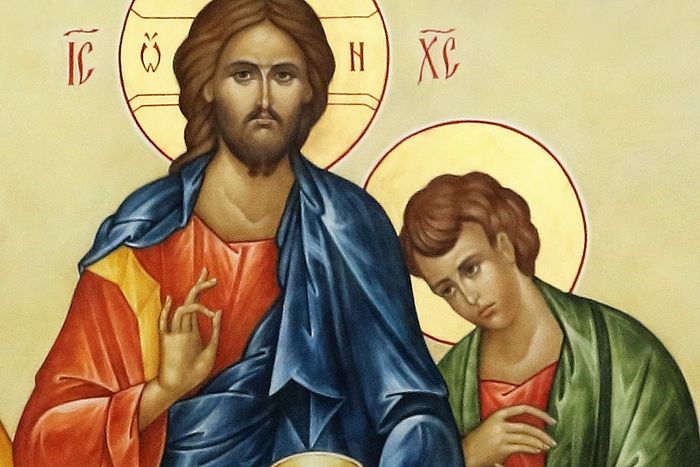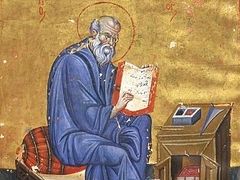Today is the most wondrous day in all the world.
And this is because we celebrate St. John, the beloved disciple of Christ the Savior—a young fisherman with eyes as clear as the sea on a May morning; the younger brother of James, the last son of Zebedee. He is a child wearied by labor, his hands calloused from ropes, his garments steeped in the scent of fish and salt, worn out from the pre-dawn vigil upon the mist-covered waters of the Sea of Galilee.
And in the heart of this child is reflected something greater than the heavens. His mind is opened, and he perceives that before him, on the shore, stands the One who surpasses all understanding and fear. And with his brother he leaves all and follows after Christ, walking with Him upon the dusty roads of Galilee, to learn how never to die.
He is the beloved disciple of the Savior, the most tender, fragrant with virginity, his eyes wide open before the avalanche of wonders, a silent child gazing as the heavens are opened, and the Spirit of God descends upon the Messiah. Then comes awe at the sight of healings—death is cast out of men; the light dawns in the eyes of the blind; deaf ears are opened to hear the Word; the paralyzed leap up, weeping and giving thanks unto the Meek One—and the disciple is silent as he watches. His eyes, like a divine sponge, absorb the torrent of light pouring forth upon the universe.
He is ever near the Master—walking at the edge of God, hearing the breath of the Creator of galaxies, eating with the Nourisher of worlds, touching with his hands the Fire that does not burn. He is so natural and innocent, and his heart above all things is steeped in the love of God. He forsakes parents and kin, casts aside the nets, and goes forth to nurture souls. He follows closely after Christ, seeing Him sweat, grow weary, smile, weep in prayer, and grieve, saying, O faithless generation, how long shall I be with you? how long shall I suffer you? (Mark 9:19).
And then, in the glory of Tabor, the holy child John sees with his heart all al history gathered in one place, kneeling in secret counsel with God; he sees Moses and Elias, the Law and the Prophets, bowed before Him who willed to die for man. John does not speak. He is so shaken that tears blind his eyes; he falls to the ground, struck by the light, overwhelmed by the outpouring of grace. On Tabor he closes his bodily eyes, but the eyes of his soul are opened to the world that lies beyond death.
Then, before the Mystical Supper, when the soul of Christ was bleeding for the pain of the millions for whom He would die, John has a moment of weakness. Together with his brother, he asks to sit on the right and on the left of the Lamb who is to be slain. And Christ says to them, Can ye drink of the cup that I drink of? and be baptized with the baptism that I am baptized with? (Mark 10:38)
And in their innocence, they reply, We can (Mark 10:39)
And the abyss of martyrdom opens within their souls; their fate is changed in a moment, and in heaven it is written how both will die for God.
And at the Divine Supper, when Christ gives His Body in the Bread of eternity, John, the very fragrance of holiness, says nothing. All are anxious, asking whether it is they who will betray the Lord. But John is silent—he is all eyes and ears. And one single gesture, transcending the ages, determines his life and his eternity—he lay his head upon the bosom of the Savior. This is the highest expression of love—silence louder than the roar of the sea, when the disciple leans upon the breast of the Creator and in wonder hears the sacred beating of the heart of God.
The history of the priesthood is likewise written there. Every priest, when ordained by the bishop, bows his head upon the holy altar—which is Christ Himself—on the right side, even as did the young John, the mystical priest of sacred love. Upon his brow is invisibly inscribed the history of the priesthood of all the earth—the offering and the gift of men, yielding their unworthy hands and lips unto God.
Then, when all others flee after Jesus is taken, John remains humbly, understanding that something is unfolding more momentous than all history. He enters into the high priest’s house—for he is known there—and brings Peter in also to the fire that shall both consume and purify him.
John, standing at the foot of the Cross, weeps with sorrow for Him who offers Himself in love for us. He heareth the breath and groaning of the Creator of the world in His agony, sees the life-giving blood flow from God’s side, and beholds how the face of the Son of Man is changed—covered in blood and thorns. And he receives the greatest gift of the ages: the commandment of Christ to care for Her who was to God the purest and most holy on earth—His Mother.
From her he learns the sacred mysteries of creation, mystical theology flowing from divine virginity. The virgin disciple hears the weeping Virgin, and in the Holy Spirit he learns what she experienced as she gave birth to God. From this springs the Gospel of the eagle—the unfathomable depth of the Mysteries of God, the theology of the eternal Logos. John is the holy gardener of the most sacred Lily in history, Mary. From her his mind drinks in the fragrance of heaven, and he inscribes it upon the parchment of humanity forever.
John is always there: with Joseph of Arimathea and Nicodemus, he bears the Body of Christ, gathers the Blood of God into the chalice of his heart, anoints the Lord with myrrh—thus beginning the holy priesthood of the Church, which offers God unto the world.
The child who once held fast to the hem of Jesus’ garment, meek and silent, becomes the confessor of the ages, the holy witness of the Resurrection, the writer of the Gospel of love, the fullness and beginning of the Synoptic tradition. His mind, rooted in God, pierced with the pain of seeing the beloved Master dying, and healed by the light of the Risen One’s eyes, becomes the most fearsome weapon against the devil. He shatters the walls of hell to dust, and writes the Apocalypse—a revelation of all the snares of the devil, a prophecy of the last days, a spear thrust into the heart of the final death.
He writes down the words that challenge all history and shake shake the foundations of hell: God is love (1 John 4:8:16). Despite his gentleness and meekness, with his word he tears asunder all the craft of satan. In the depths of the cave on Patmos he is caught up to the feet of the Crucified King and beholds His triumph over the world.
What a wondrous man do we celebrate today! And how far we are from the sighs of his heart. Let us turn unto his words and tears—before it be too late.




